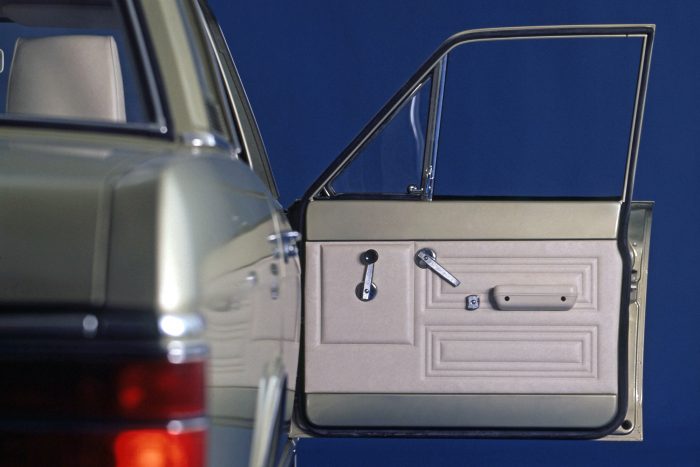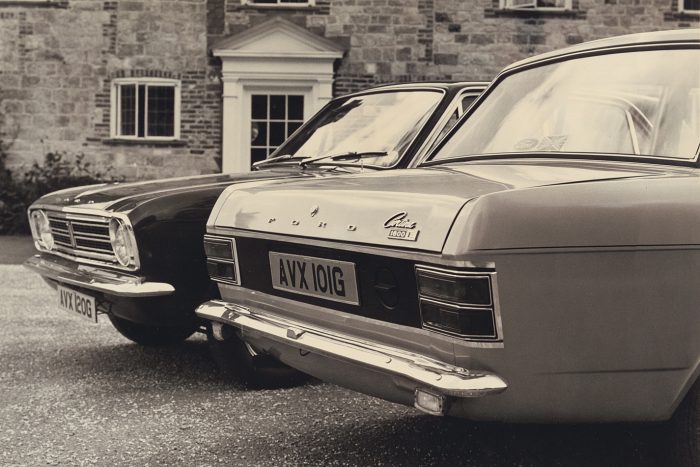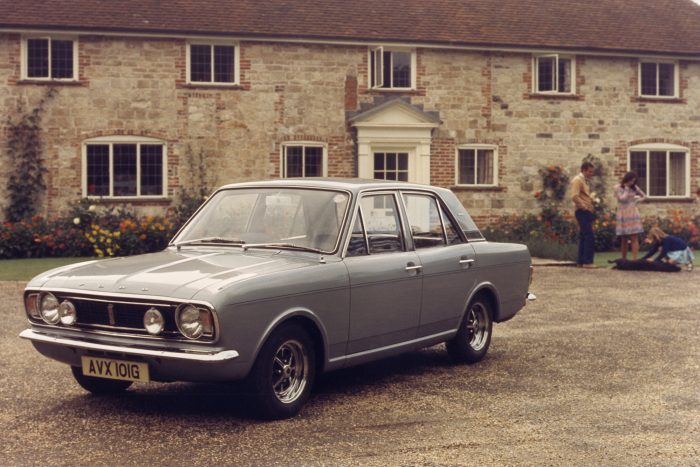In the autumn of 1968 the MkII Cortina range received a facelift. At a glance the Series II models didn’t appear very different but in fact virtually the whole car had been redesigned and reengineered.
Some of these changes were driven by Fords fight against what they called NVH, that’s Noise, Vibration and Harshness. For the MkII this meant changing the shape of windscreen pillars and front doors, and fitting different shaped door seals in an effort to cut down on wind noise.Similarly, the leaf springs on all models but the Twin Cams were changed to incorporate a larger softer rear bush to help give a more compliant and quieter ride. For the 1600E, Ford engineers went a step further and added rubber insulators between the rear axle and leaf springs. This was also the moment the GTs finally had their anti tramp bars deleted once and for all.

Series II 1600E interior with the export spec safety padded Steering wheel
Other changes were safety driven. New window winders had break off knobs to help protect occupants knees and dashboard mounted handbrake levers were moved to the gearbox tunnel for the same reason for almost all models. To help protect heads there were new dashboards for the GT, 1600E and Twin Cam models. This change moved the four auxiliary gauges from the binnacle on top of the crash pad to become an integral part of the dashboard. All models benefitted with new flatter wider switch knobs also to help protect occupants heads in case of accidents.Elsewhere in the interior the speedometer swapped positions with the fuel/temperature gauge and tachos, the Deluxes gained carpets and door trim cards from the other models. Deluxes also got slightly different seat covers while the rest of the range got completely new seats. There was new material for the headlining and a redesigned centre console for the GT, 1600E, and Lotus models. This went all the way up to the dashboard and included a cubby hole that could be swapped to take a radio. The new console also removed the armrest in favour of seatbelt buckle storage location points.
Externally, the oval Ford badge on the passenger side front wing was deleted to be replaced by F O R D lettering across the bonnet and boot lids. As all MkIIs now had an internal bonnet release, new taller grill badges were introduced to cover the hole left by the old external release button. The foil in the grill badges changed colour from red to blue at the same time.Stainless trims were added to the rear ends on the Super, GT, 1600E and Twin Cam models with the 1600E getting the center section of it’s rear panel painted satin black.
The rear panel had had drainage reliefs added to the boot seal channel earlier in production but there were now changes made to many other panel pressings too. The dashboard metal for the GT, 1600E and Lotus models was updated to accommodate the new position of the gauges, the bulkhead panel was flatter and squarer, and reliefs on the inner wings for the larger master cylinders of the export cars were adopted for all shells. There was also a new larger gearbox tunnel for the manual cars, positions of some of the rubber bung holes were moved in the floors and seatbelt mounting points in the B pillar were also revised.
Mechanical upgrades included an all new single rail manual gearbox across almost the whole the range giving all models a remote gear change – automatics, and the cars with the manual column gear change, kept the same gearboxes as before. The new shorter gearboxes required longer prop shafts, the two piece split prop shaft for the Twin Cam also got a new style centre bearing and support.In the engine bay the bulkhead/bonnet rubber sealing strip was deleted and the positions of the coil and regulator boxes changed. Brake pipes were rerouted with the 4 way splitter moving to the heater plenum bowl, and where fitted, there were new style brake servos. The steel cooling fans were replaced with a new light weight multi bladed plastic item, and new wiring looms put fuses in to the lighting circuit for the first time.

This style of door card was fitted from 12/67 in North America and from 8/69 in Sweden
For the UK home market cars there were no other major changes through to the end of production, but to meet local laws and tastes specifications had been different for other markets.Some markets preferred the 2dr cars, others the 4drs. Some markets never got the estates and many used the heavy duty body shells of the 1600E and Lotus for Deluxe and Super cars. Cars for some of the warmer parts of the world didn’t get heaters. US Federal cars had running side lights and emission control hardware added, and ran dual line braking systems. Swedish cars got the dual line brakes too but also ran with two remote servos, others kept their single line brakes but made use of a direct servo requiring a special pressing for the inner wing. These particular cars had their batteries moved to the opposite (passenger) side of the engine bay.Trim levels and models changed across the different markets too, US Deluxes being very close to the UK Super specification for example though could have very different dashboards. Australia, like the US, never got the 1600E while New Zealand had a roughly equivalent model known as the GTE.
Primarily the MkII Cortina was built at Dagenham, these cars will have a chassis number beginning BA. Chassis numbers beginning BB will be a car from the overflow production line at the Halewood plant in Liverpool. Knock down kits to be finished locally were also sent across the world normally will have chassis numbers beginning CN. To get around the Australian heavy taxes on imported cars, Ford fitted enough locally made parts for it to be considered an Australian car and avoid the import tax.









